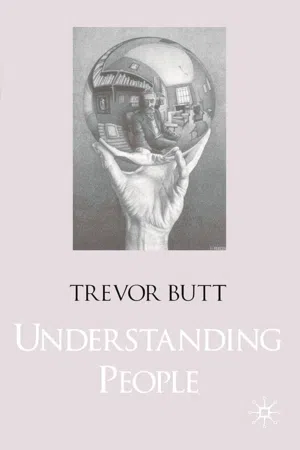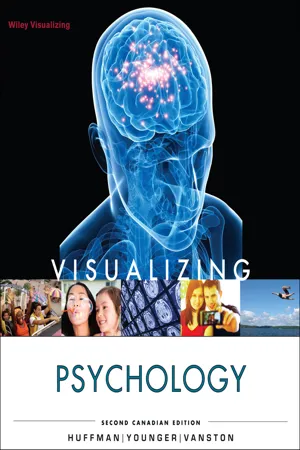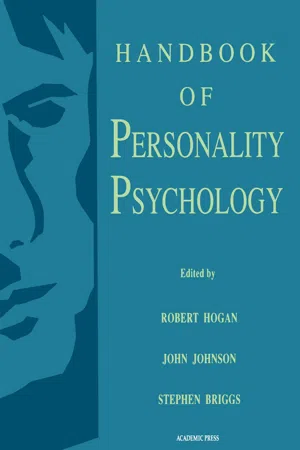Psychology
Theories of Personality
Theories of personality in psychology are frameworks that seek to explain and understand individual differences in behavior, thoughts, and emotions. These theories attempt to identify and describe the underlying factors that shape an individual's personality, such as genetics, environment, and personal experiences. They provide valuable insights into human behavior and contribute to our understanding of individual differences.
Written by Perlego with AI-assistance
Related key terms
1 of 5
10 Key excerpts on "Theories of Personality"
- No longer available |Learn more
Psychology Applied to Modern Life
Adjustment in the 21st Century
- Wayne Weiten, Dana Dunn, Elizabeth Hammer(Authors)
- 2014(Publication Date)
- Cengage Learning EMEA(Publisher)
Cengage Learning reserves the right to remove additional content at any time if subsequent rights restrictions require it. 64 CHAPTER 2 Key Ideas THE NATURE OF PERSONALITY ● The concept of personality explains the consistency in individu- als’ behavior over time and situations while also explaining their distinctiveness. Personality traits are dispositions to behave in certain ways. ● Some theorists suggest that the complexity of personality can be reduced to just five basic traits: extraversion, neuroticism, open- ness to experience, agreeableness, and conscientiousness. The Big Five traits predict important life outcomes, such as grades, occupa- tional attainment, divorce, health, and mortality. PSYCHODYNAMIC PERSPECTIVES ● Freud’s psychoanalytic theory emphasizes the importance of the unconscious. Freud described personality structure in terms of three components (id, ego, and superego), operating at three levels of awareness, that are involved in internal conflicts, which generate anxiety. ● According to Freud, people often ward off anxiety and other unpleasant emotions with defense mechanisms, which work through self-deception. He described five psychosexual stages that children undergo in their personality development. ● Jung’s analytical psychology stresses the importance of the col- lective unconscious. Adler’s individual psychology emphasizes how people strive for superiority to compensate for feelings of inferiority. BEHAVIORAL PERSPECTIVES ● Behavioral theories view personality as a collection of response tendencies shaped through learning. Pavlov’s classical condition- ing can explain how people acquire emotional responses. ● Skinner’s model of operant conditioning shows how conse- quences such as reinforcement, extinction, and punishment shape behavior. Bandura’s social cognitive theory shows how people can be conditioned indirectly through observation. He views self-efficacy as an especially important personality trait. - eBook - PDF
- Ronald Comer, Elizabeth Gould, Adrian Furnham(Authors)
- 2014(Publication Date)
- Wiley(Publisher)
In fact, there has been something of a renaissance in what is called differential psychology because of four things. First, growing agreement about the description and understand- ing of the basic dimensions of personality. Second, a greater understanding of the heritability of personality and the role of the social environment in shaping it. Third, an understand- ing of the biological processes that cause these differences and, fourth, the extent to which personality predicts all sorts of outcomes like educational and work success, relationship building and maintenance as well as long-term mental and physical health. One question people ask is how to select among different personality theories: which is best? There are various criteria one could apply. Does it describe or explain all important aspects of human behaviour simply? Is the theory clear and free of jargon? Can it be tested with precision, and what is the evidence from those who have tested it? In short, is it empiri- cally valid? And has it stimulated others to work in the area and apply it to other aspects of life? The Psychodynamic Perspective LEARNING OBJECTIVE 1 Summarize the main ideas of the psychodynamic view of per- sonality development. The psychodynamic model emphasizes the unconscious, often dark desires (mainly about sex and aggression) that have to be held in check. The model was formulated by the Viennese neurologist Sigmund Freud (1856–1939) at the beginning of the 20th century. In Freud’s view, the personality forms as a result of struggles between primal needs and social or moral restraints. Many other theorists who follow Freud’s key prin- ciples differ from him in certain ways. The basic assumptions of the theory are essentially these: all social behaviour is the result of fights and compromises between powerful and unconscious drives, motives and needs. - Lorelle J. Burton, Drew Westen, Robin M. Kowalski(Authors)
- 2022(Publication Date)
- Wiley(Publisher)
Psychodynamics has been one of the most influential and provocative fields of study in psychology and has helped usher in new ways of thinking about human behaviour. APPLY AND DISCUSS What are the basic components of personality from a psychodynamic perspective? Apply this model to yourself or someone you know well. • How would you describe your own wishes, fears, con- ficts, compromises, desires or thoughts you would rather not admit, fxations or regressions, ego functions (including defences) and object relations? • To what extent are these elements of personality stable over time? Could a person change them, and if so, how? 14.3 Cognitive–social theories LEARNING OUTCOME 14.3 Discuss the basic principles of the cognitive–social Theories of Personality. Cognitive–social theories offered the first comprehensive alternative to psychodynamic Theories of Personality. First developed in the 1960s, these theories go by several names, including social learning theory, cognitive–social learning theory and social–cognitive theory. Cognitive–social theories developed from behaviourist and cognitive roots; we have already examined several aspects of these theories in some detail (chapter 9). From a behaviourist perspective, personality consists of learned behaviours and emotional reactions that are relatively specific and tied to particular environmental stimuli or events. Many of these behaviours are selected through operant conditioning on the basis of their rewarding or aversive consequences. Cognitive– social theories share the behaviourist belief that learning (rather than instinct, conflict or defence) is the basis of personality and that personality dispositions tend to be relatively specific and shaped by their consequences. However, they also focus on beliefs, expectations and information processing.- eBook - PDF
- Nancy Ogden, Michael Boyes, Evelyn Field, Ronald Comer, Elizabeth Gould(Authors)
- 2021(Publication Date)
- Wiley(Publisher)
As we discussed back in Chapter 4, psychologists and biologists have come to acknowledge that environmental experience and biological mechanisms work together to shape personality. In this chapter, we will first explore key historic perspectives on the “why” question in personal- ity: the psychodynamic, humanistic, trait, situationist, and interactionist perspectives. We then look at the important role played by genetic predispositions in personality and what researchers have discovered about the contributions of both genetic and environmental factors. Next, we examine how personality is assessed in individuals and whether personality differs depending on gender and culture. And finally, we describe various personality disorders. The Psychodynamic Perspective LEARNING OBJECTIVE 1 Summarize the main ideas of the psychodynamic view of personality development. As you read in Chapters 1 and 6, the psychodynamic (or psychoanalytic) model emphasizes the unconscious, often dark desires that have to be held in check. Recall also from those chap- ters that the model was formulated by the Viennese neurologist Sigmund Freud (1856–1939) personality the unique charac- teristics that account for enduring patterns of inner experience and outward behaviour. The Psychodynamic Perspective 491 at the beginning of the twentieth century. Freud, like his contemporary Charles Darwin (Mon- cayo, 2018), believed that a full account of human psychology and personality needed to include acknowledgement that humans, like other animals, have some basic wired-in drives of instincts. In Freud’s broadly cast efforts to address the “why” question, the personality forms as a result of struggles between primal needs and social or moral restraints. Many other theorists who follow Freud’s key principles differ from him in certain ways. However, they share his basic notion that personality and behaviour are shaped by interacting, or dynamic, underlying forces. - eBook - PDF
- Trevor Butt(Author)
- 2017(Publication Date)
- Bloomsbury Academic(Publisher)
indicates that almost any type of therapy is successful with some pro-blems in some people. For the past thirty years, researchers have focused on what sort of problems bene¢t from which type of therapy. The research has made some useful suggestions, but being able to pre-dict does not imply understanding. Knowing that monosympto-matic phobias (that is, phobias with a single focus, say spiders, heights or needles) are often successfully treated with systematic desensitisation is not the same as knowing why this is the case . The-ories of personality exist to provide explanation and understanding; why we are di¡erent from others, why we think, feel and act as we do and why change occurs. They propose widely di¡erent structures and processes to account for individual di¡erences, yet they are alike in many ways. With the interesting exception of Skinner (who, as we have seen, would not regard himself as a personality theorist), they all hold dualist assumptions about the person, assuming an inner essence that makes its appearance through behaviour. In their search for explanation, they all stress causal relationships; some emphasise the power of situational variables, but most look inside the person for causal explanations. And they are all individualistic, assuming the existence of essentially separate individuals who predate the social world. These similar features can be seen as typical of modern scien-ti¢c thought. Personality: a modern concept Let us now consider these points of similarity, examining the role of theory in the psychology of personality. One of the main purposes of theory in any ¢eld is to achieve understanding. Theories exist to help us to interpret and grasp the meaning of events. Scienti¢c endeavour is characterised by the generation of theories that are designed to explain and make sense of di¡erent aspects of the world. This is part of the modern scienti¢c project that dates back approximately three hundred years. - eBook - PDF
Psychology and the Challenges of Life
Adjustment and Growth
- Spencer A. Rathus, Jeffrey S. Nevid(Authors)
- 2019(Publication Date)
- Wiley(Publisher)
On a personal level, to better understand your present behavior as a student or a worker, we need to learn more about your individual history of rewards and punishments. To the traditional behaviorist, Humanistic Theory 67 your personality is nothing more than the sum total of your learned behaviors. Many contem- porary learning theorists, however, take a broader view of the learning process. These theorists, generally called social cognitive theorists, expand the traditional view of learning to include cognitive factors such as expectancies and observational learning. Social cognitive theorists view people as active seekers and interpreters of information in the environment, not merely as reactors to environmental forces acting on them. But like psychodynamic theory, learning theory models of personality have also been subject to criticism. To some critics, learning models fail to account for the roles of unconscious influences in determining behavior. Others have voiced concern that learning models fail to give sufficient attention to the influence of heredity or to the development of personality traits or styles, or that they lack the ability to provide a meaningful account of self-awareness. Let’s now turn our attention to humanistic theory, which, like social cognitive theory, emphasizes cognitive processes and conscious experience. Humanistic Theory Humanistic psychologists focus our attention on the meaning of life—or, rather, the meaning with which we imbue our lives. The term humanism has a long history and many meanings. It became a third force in American psychology in the 1950s and 1960s, partly in response to the predom- inant model of determinism espoused by psychodynamic and behavioral theorists (Grogan, 2013). To the humanistic theorists, humans are not puppets on a string controlled by the invisible puppet masters of internal mental structures or environmental influences. - eBook - PDF
Essentials of Psychology
Concepts and Applications
- Jeffrey Nevid(Author)
- 2021(Publication Date)
- Cengage Learning EMEA(Publisher)
i. personal perceptions of events ii. belief in personal effectiveness iii. personal knowledge and skills iv. environmental influences Recall It ■ How does social-cognitive theory represent a shift in learning-based Theories of Personality? ■ Do you believe the roots of personality lie more in the environment or in the person? Explain. ■ How is your behavior influenced by outcome and efficacy expectations? By subjective values? Think About It Humanistic psychology departed from the psychodynamic and behaviorist schools in proposing that conscious choice and personal freedom are central features of what it means to be a human being (Grogan, 2013). To humanistic psychologists, we are not puppets whose movements are controlled by strings pulled by the MODULE 8 Describe the self-theory of humanistic theorist Carl Rogers. 9 Explain the difference between the concepts of self in collectivistic and individualistic cultures. 10 Apply suggestions for enhancing self-esteem. The Humanistic Perspective 11.4 Copyright 2022 Cengage Learning. All Rights Reserved. May not be copied, scanned, or duplicated, in whole or in part. Due to electronic rights, some third party content may be suppressed from the eBook and/or eChapter(s). Editorial review has deemed that any suppressed content does not materially affect the overall learning experience. Cengage Learning reserves the right to remove additional content at any time if subsequent rights restrictions require it. 440 CHAPTER 11 PERSONALIT Y unconscious mind or the environment; rather, we are endowed with the ability to make free choices that give meaning and personal direction to our lives. Two of the major contributors to humanistic thought were the American psychologists Carl Rogers (1902–1987) and Abraham Maslow (1908–1970). Carl Rogers: The Importance of Self To Carl Rogers each of us possesses an inner drive that leads us to strive toward self-actualization—toward realizing our own unique potentials (Rogers, 1961, 1980). - eBook - PDF
- Spencer Rathus, , , (Authors)
- 2021(Publication Date)
- Cengage Learning EMEA(Publisher)
Similarly, psychodynamic theorists and trait theorists focus on internal variables such as unconscious conflict and traits to explain and predict behavior. Learning theorists emphasize the importance of environmental conditions, or situational variables, as determinants of behavior. They have also elaborated on the conditions that foster learning, including automatic kinds of learning. They have shown that we can learn to do things because of reinforcements and that many behaviors are learned by observing others. Social cognitive theory does not account for self-awareness and, as its intellectual forebear, behaviorism, it may not pay enough attention to genetic variation in explaining individual differences in behavior. 10-4 THE HUMANISTIC–EXISTENTIAL PERSPECTIVE Humanists and existentialists dwell on the meaning of life. Self-awareness is the hub of the humanistic–existen-tial search for meaning. The term humanism variables include rewards and punishments. Person vari-ables include knowledge and skills, ways of interpreting experience, expectancies, emotions, and self-regulatory systems and plans (Bandura, 2012). See Figure 10.5. We cannot predict behavior from situational variables alone. Whether a person will behave in a certain way also depends on the person’s expectancies about the outcomes of that behavior and the perceived or subjective values of those outcomes. There are various kinds of expectancies. Some are predictions about what will follow what. For example, people might predict other people’s behavior on the basis of body language such as “tight lips” or “shifty eyes.” Self-efficacy expectations are beliefs that we can accomplish cer-tain things, such as doing a backflip into a swimming pool or solving math problems. People with positive self-efficacy expectations tend to have high self-esteem and achieve-ment motivation. - eBook - PDF
- Karen R. Huffman, Alastair Younger, Claire Vanston(Authors)
- 2013(Publication Date)
- Wiley(Publisher)
Enduring influences • The emphasis on the unconscious and its influence on behaviour. • The conflict among the id, ego, and superego and the resulting defence mechanisms. • Encouraging open talk about sex in Victorian times. • The development of psychoanalysis, an influential form of therapy. • The sheer magnitude of Freud’s theory. Humanistic Theories 337 Rogers’ Theory: The Importance of the Self To psychologist Carl Rogers (1902–1987), the most impor- tant component of personality is the self—what a person comes to identify as “I” or “me.” Today, Rogerians (followers of Rogers) use the term self-concept to refer to all the information and beliefs you have regarding your own nature, unique qualities, and typical behaviours. umanistic Theories of Personality emphasize each person’s internal feelings, thoughts, and sense of basic worth. Humanists believe that people are naturally good (or, at worst, neutral), and that our personality and behaviour depend on how we perceive and interpret the world. Indeed, as noted by Jeanne Watson of the University of Toronto and Leslie Greenberg of York University in Toronto, the humanistic approach emphasizes our drive toward self-fulfillment and growth, our capacity for self-reflection, and our ability to make choices in our lives (Watson & Greenberg, 1996; Watson, Goldman, & Greenberg, 2011). Two of the most prominent humanistic psychologists were Carl Rogers and Abraham Maslow. H 1. Explain the importance of the self in Rogers’ theory of personality. 2. Describe how Maslow’s hierarchy of needs affects personality. 3. Identify three criticisms of humanistic theories. - eBook - PDF
- Robert Hogan, John Johnson, Stephen Briggs(Authors)
- 1997(Publication Date)
- Academic Press(Publisher)
Another increasingly influential system for conceptualizing individual differ-ences comes from the longitudinal investigations of Block (1971, 1993; Funder, Parke, Tomlinson-Keasey, & Widaman, 1993) employing the California Q Set. Two major dimensions underlying the various personality types and developmental trajectories identified by Block and his colleagues are ego resiliency and ego control. At the current time, the most influential formulation of individual differences in personality is the Big Five trait taxonomy. Building on the early work of Fiske (1949), Norman (1963), and Tupes and Christal (1961), a number of personality psychologists have proposed that the universe of trait dimensions can be reduced to approximately five basic bipolar categories (Digman, 1990; Goldberg, 1981,1993; John, 1990; McCrae, 1992; McCrae & Costa, 1987). Different factor-analytic studies have cut the pie in slightly different ways, but a representative breakdown is that of McCrae and Costa (1987), who identify the five as (1) extraversion-introversion (E) (2) neuroticism (N), (3) openness to experience (O), (4) agreeableness-antagonism (A), and (5) conscientiousness-undirectedness (C). Goldberg's pains-taking lexical analyses suggest that these five dimensions are encoded in language. At least in the case of English, these five may serve as the grand organizing dimen-sions with respect to which virtually all trait labels for describing general noncondi-tional individual differences in human behavior and experience can be construed. VI. CONCLUSIONS: PROGRESS AND STAGNATION In conclusion, the history of personality psychology in the twentieth century may be broadly viewed from the standpoint of conceptual progress and stagnation. The field of personality has traditionally emphasized the study of the whole person, the dynamics of human motivation, and the identification and measurement of individ-
Index pages curate the most relevant extracts from our library of academic textbooks. They’ve been created using an in-house natural language model (NLM), each adding context and meaning to key research topics.









